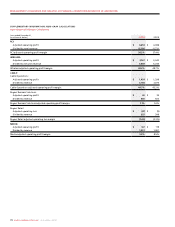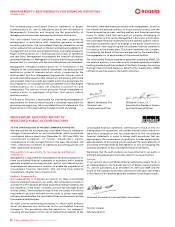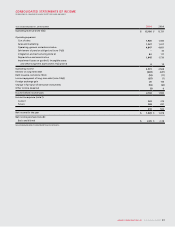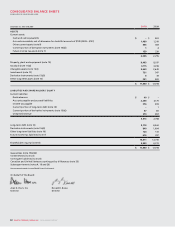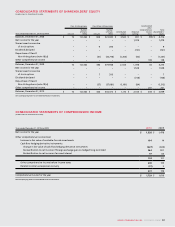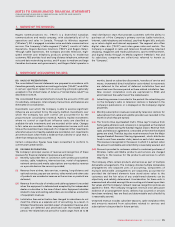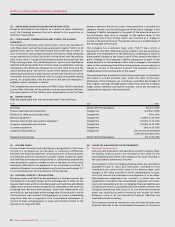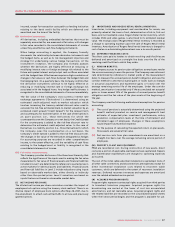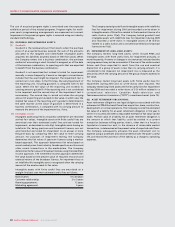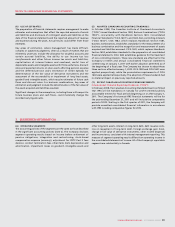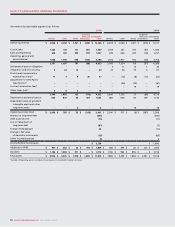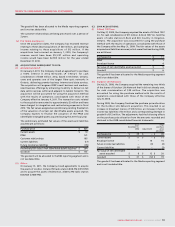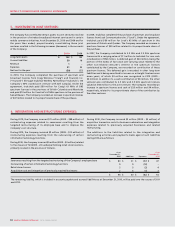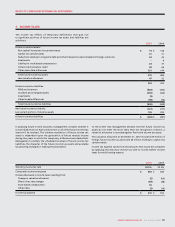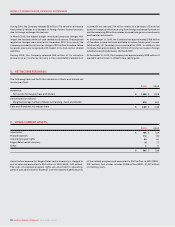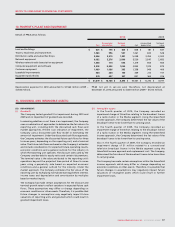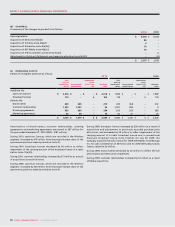Rogers 2010 Annual Report Download - page 84
Download and view the complete annual report
Please find page 84 of the 2010 Rogers annual report below. You can navigate through the pages in the report by either clicking on the pages listed below, or by using the keyword search tool below to find specific information within the annual report.
NOTES TO CONSOLIDATED FINANCIAL STATEMENTS
88 ROGERS COMMUNICATIONS INC. 2010 ANNUAL REPORT
The cost of acquired program rights is amortized over the expected
exhibition period of the related programs. Program rights for multi-
year sports programming arrangements are expensed as incurred.
Impairment of acquired program rights is assessed using an industry
standard methodology.
(O) GOODWILL AND INTANGIBLE ASSETS:
(i) Goodwill:
Goodwill is the residual amount that results when the purchase
price of an acquired business exceeds the sum of the amounts
allocated to the tangible and identifiable intangible assets
acquired, less liabilities assumed, based on their fair values. When
the Company enters into a business combination, the purchase
method of accounting is used. Goodwill is assigned, as of the date
of the business combination, to reporting units that are expected
to benefit from the business combination.
Goodwill is not amortized but instead is tested for impairment
annually, or more frequently, if events or changes in circumstances
indicate that the asset might be impaired. The impairment test is
carried out in two steps. In the first step, the carrying amount of
the reporting unit, including goodwill, is compared with its fair
value. When the fair value of the reporting unit exceeds its
carrying amount, goodwill of the reporting unit is not considered
to be impaired and the second step of the impairment test is
unnecessary. The second step is carried out when the carrying
amount of a reporting unit exceeds its fair value, in which case, the
implied fair value of the reporting unit’s goodwill, determined in
the same manner as the value of goodwill is determined in a
business combination, is compared with its carrying amount to
measure the amount of the impairment loss, if any.
(ii) Intangible assets:
Intangible assets acquired in a business combination are recorded
at their fair values. Intangible assets with finite useful lives are
amortized over their estimated useful lives and are tested for
impairment, as described in note 2(p). Intangible assets having an
indefinite life, being spectrum and broadcast licences, are not
amortized but are tested for impairment on an annual or more
frequent basis by comparing their fair value to their carrying
amount. For purposes of impairment testing, the Company
determines the fair value of spectrum licences using a market-
based approach. This approach determines fair value based on
recent market prices from Industry Canada spectrum auctions and
other recent transactions in the marketplace. The Company
determines the fair value of broadcast licences using the Greenfield
income approach. The Greenfield income approach determines
the value based on the present value of required resources and
eventual returns of the broadcast licences. An impairment loss on
an indefinite life intangible asset is recognized when the carrying
amount of the asset exceeds its fair value.
Intangible assets with finite useful lives are amortized on a
straight-line basis over their estimated useful lives as follows:
Brand names 5 to 20 years
Customer relationships 2 to 5 years
Roaming agreements 12 years
Marketing agreement 5 years
The Company tested goodwill and intangible assets with indefinite
lives for impairment during 2010 and recorded a write-down in
intangible assets of $6 million related to the broadcast licence of a
radio station (note 11(a)). The Company tested goodwill and
intangible assets with indefinite lives for impairment during 2009
and recorded a write-down in intangible assets of $5 million
related to a radio station and a conventional television broadcast
licence (note 11(a)).
(P) IMPAIRMENT OF LONG-LIVED ASSETS:
The Company reviews long-lived assets, which include PP&E and
intangible assets with finite useful lives, for impairment annually, or
more frequently, if events or changes in circumstances indicate that the
carrying amount may not be recoverable. If the sum of the undiscounted
future cash flows expected to result from the use and eventual
disposition of a group of assets is less than its carrying amount, it is
considered to be impaired. An impairment loss is measured as the
amount by which the carrying amount of the group of assets exceeds its
fair value.
The Company tested long-lived assets with finite useful lives for
impairment during 2010 and no write-downs were required. The
Company tested long-lived assets with finite useful lives for impairment
during 2009 and recorded a write-down of $13 million related to a
conventional television Canadian Radio-television and
Telecommunication Commission (“CRTC”) commitments asset (note 13).
(Q) ASSET RETIREMENT OBLIGATIONS:
Asset retirement obligations are legal obligations associated with the
retirement of PP&E that result from their acquisition, lease, construction,
development or normal operations. The Company records the estimated
fair value of a liability for an asset retirement obligation in the year in
which it is incurred and when a reasonable estimate of fair value can be
made. The fair value of a liability for an asset retirement obligation is
the amount at which that liability could be settled in a current
transaction between willing parties, that is, other than in a forced or
liquidation transaction and, in the absence of observable market
transactions, is determined as the present value of expected cash flows.
The Company subsequently allocates the asset retirement cost to
expense using a systematic and rational method over the asset’s useful
life, and records the accretion of the liability as a charge to operating
expenses.


